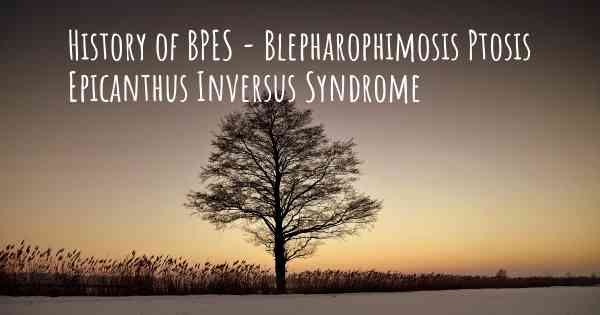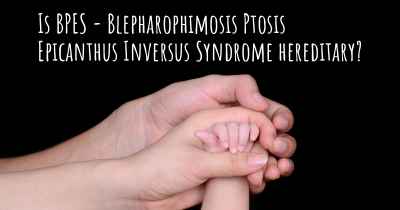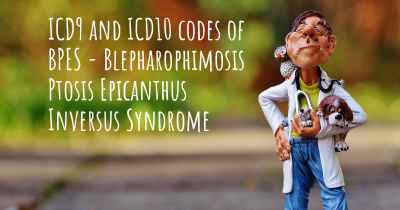What is the history of BPES - Blepharophimosis Ptosis Epicanthus Inversus Syndrome?
When was BPES - Blepharophimosis Ptosis Epicanthus Inversus Syndrome discovered? What is the story of this discovery? Was it coincidence or not?

BPES - Blepharophimosis Ptosis Epicanthus Inversus Syndrome: A Historical Overview
Blepharophimosis Ptosis Epicanthus Inversus Syndrome (BPES) is a rare genetic disorder that primarily affects the development of the eyelids and surrounding structures. This condition was first described in medical literature in the early 20th century, and since then, significant progress has been made in understanding its causes, symptoms, and management.
Early Discoveries and Classification:
The term "BPES" was coined in 1979 by Gorlin et al., who recognized the distinct combination of blepharophimosis (narrowing of the eyelid opening), ptosis (drooping of the upper eyelid), and epicanthus inversus (an upward fold of skin near the inner corner of the eye) in affected individuals. However, the syndrome had been observed and reported earlier by various researchers.
Genetic Basis:
BPES is a genetic disorder with two main subtypes: type I and type II. Type I BPES is characterized by eyelid abnormalities and premature ovarian failure (POF) in affected females. Type II BPES primarily involves only the eyelid abnormalities and does not affect ovarian function.
Research conducted over the years has identified the underlying genetic mutations responsible for BPES. The majority of cases are caused by mutations in the FOXL2 gene, located on the long arm of chromosome 3. FOXL2 is a transcription factor that plays a crucial role in the development of various tissues, including the eyelids and ovaries.
Clinical Presentation and Diagnosis:
Individuals with BPES typically present with characteristic eyelid abnormalities, including narrow palpebral fissures (the opening between the eyelids), drooping of the upper eyelids, and an upward fold of skin near the inner corner of the eye. These features can vary in severity among affected individuals.
Diagnosis of BPES is primarily based on clinical examination and the presence of characteristic features. Genetic testing can confirm the diagnosis by identifying mutations in the FOXL2 gene.
Management and Treatment:
Management of BPES involves a multidisciplinary approach, including ophthalmologists, geneticists, and other specialists. The treatment primarily focuses on addressing the functional and cosmetic concerns associated with the eyelid abnormalities.
For individuals with significant ptosis, surgical correction may be recommended to improve vision and enhance the appearance of the eyes. Various surgical techniques, such as levator resection or frontalis suspension, can be employed depending on the severity of ptosis.
Advancements and Future Directions:
Advancements in genetic research have significantly contributed to our understanding of BPES. The discovery of FOXL2 mutations as the primary cause of BPES has paved the way for further investigations into the molecular mechanisms underlying the syndrome.
Ongoing research aims to explore potential therapeutic interventions targeting the underlying genetic abnormalities. Gene therapy and other emerging technologies hold promise for future treatment options, potentially offering more targeted and personalized approaches for individuals with BPES.
Conclusion:
BPES, or Blepharophimosis Ptosis Epicanthus Inversus Syndrome, is a rare genetic disorder primarily affecting the eyelids and surrounding structures. First described in the late 1970s, BPES has since been extensively studied, leading to the identification of FOXL2 gene mutations as the main cause. Clinical management involves a multidisciplinary approach, with surgical correction being the primary treatment for eyelid abnormalities. Ongoing research aims to further unravel the molecular mechanisms underlying BPES and explore potential therapeutic interventions.








